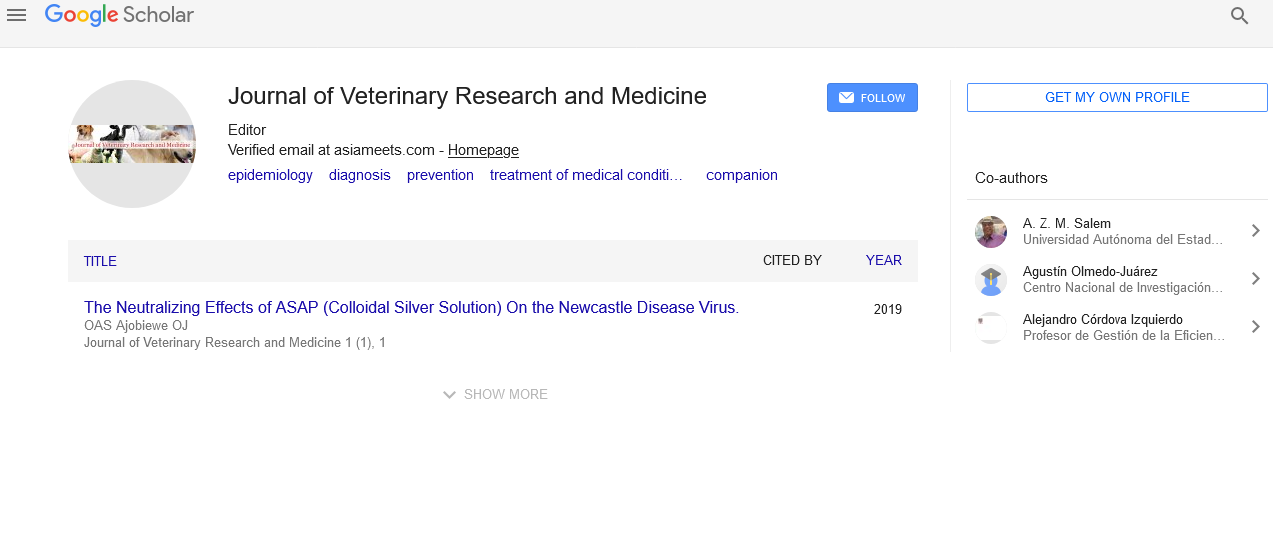ETHNOBOTANY IN RABBITS
Received: 17-Feb-2022, Manuscript No. PULJVRP-22-4273; Editor assigned: 21-Feb-2022, Pre QC No. PULJVRP-22--4273(PQ); Accepted Date: Mar 03, 2022; Reviewed: 23-Feb-2022 QC No. PULJVRP-22-4273; Revised: 28-Feb-2022, Manuscript No. PULJVRP-22-4273(R); Published: 07-Mar-2022
This open-access article is distributed under the terms of the Creative Commons Attribution Non-Commercial License (CC BY-NC) (http://creativecommons.org/licenses/by-nc/4.0/), which permits reuse, distribution and reproduction of the article, provided that the original work is properly cited and the reuse is restricted to noncommercial purposes. For commercial reuse, contact reprints@pulsus.com
Abstract
Bunny rearing is a developing movement in Benin. Hare meat utilization expanded further to bird influenza in 2005 and of Ebola hemorrhagic fever in 2013. The cooperation of conventional bunny reproducing in Benin’s economies is thusly expanded. Be that as it may, the creation and development execution of bunnies were subject to a decent and promptly accessible taking care of and great reproducing conditions. Useful reproducing of these creatures subsequently requires non-occasionally subordinate scavenge. Bunny reproducing is faced with wellbeing and food limitations that limit the statement of zoo technical execution of animals on ranches and diminish the accessibility of meat per capita. To the present circumstance is added to the development of parasites impervious to numerous manufactured particles, joined with detachment and non-accessibility of veterinary items incline the stock raisers toward resort today to therapeutic plants. Those plants would accommodate this reason a restorative reaction adjusted to the monetary means and the socio-social climate of the reproducers.
Key Words
Veterinary; Ethnobotany; Bunny rearing
Introduction
Ethnobotany overview was completed in the six (6) divisions of South Benin: Atlantic, Littoral, Mono, Cuff, Outmen, and Plateau. The review region is situated between 620′ and 730 Northern scope, 140′ and 245′ of longitude East. It covers a surface of 11866 km2 for a populace of 5042628 occupants. This area of Benin is portrayed by a few environment. Without a doubt, the branches of Atlantic, Littoral, Mono, Coffs and Outmen were basically set apart by a subequatorial environment described by two dry seasons and two downpours seasons with on normal downpour measure of 1200 mm by year and a variation temperature differing on normal between 27°C and 31°C agreeing the National Institute of Statistics and Economic Analysis. The division of Plateau has an environment of Sodano-Guinean sort of two-downpour seasons, a pluviometry included between 800 mm and 1200 mm in its Western part between 1000 mm and 1400 mm in its East part.
The system utilized is that of a review study on the pathologies and customary treatments utilized by bunny’s reproducers to forestall or regard pathologies when they show up. A singular review poll was utilized. It gives data on the personality of the witness, the taking care of creatures, the parasitic pathologies experienced, their causes, and the customary natural cures used to treat them.
Background
All reproducers of hare were distinguished utilizing the non-probabilistic snowball strategy. Notwithstanding, the decision of stock raisers depended on their great information on reproducing rehearses and a decent information on the utilization of phyto medicine in hare creation. The overview permitted gathering data from 248 bunnies raisers. The restorative plants utilized by the reproducers were gathered and distinguished in situ utilizing Benin’s logical greenery, as indicated by and guaranteed by the National Herbarium of Benin.
Hare raisers settle on the quantity of buck bunnies in their reproducing as indicated by the quantity of hare’s does they own. We most frequently counted 1 to 2 buck rabbits for each 10 bunnies’ does. Females were basically recreated interestingly around the fifth month all things considered. In hare rearing, the litter is 6 to 8 on normal for each farrowing. Nonetheless, high litters (10 units to 13 units) were likewise recorded. These outcomes support crafted showed that the age of the bunnies for the main generation is about 5 months and that the bunny doe give somewhere in the range of 1 and 12 packs by farrowing of which 5 to 7 units on normal in the equatorial area. Still birth subsequent to weaning hares is high and midpoints around 10%. This showed that during stuffing, packs were delicate to the new unfriendly clean climate.
Conclusion
They most frequently capitulate to a coccidian pervasion, particularly without a trace of customary checking.
Rather than hare’s doe, units don’t profit from any compelling resistance communicated by the bunny doe. There is no cross invulnerability between the species. Just cell-interceded resistance gives genuine insurance to units. These creators additionally accentuate the job of nearby invulnerability.
This study made it conceivable to evaluate the degree of information on the utilization of plants by raisers and agro-pastoralists in Benin to treat different parasitic pathologies in hares. This study uncovered that hare reproducers have a decent potential for native information that can work on creature wellbeing. Considering the variety of plant species recognized in this review, four species have been given extraordinary consideration relying upon the quantity of pathologies they treat and their reference files. These were Moringa, Oleifera, Ocimum gratissimum, Vernonia Amygdalina and Carica papaya. In context, it is intended to do a bibliographic investigation of the most referred to plants, and complete productivity trial of a portion of these plants for a superior use by the bunnies’ reproducers.





